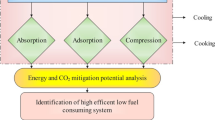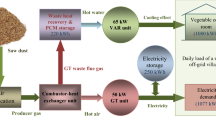Abstract
An integrated strategy of replacing boiler fuel and vapour compression cooling technology in dried mango chips processing plant powered on-grid and off-grid was investigated. Three scenarios for each power setting were studied: on-grid: coal as boiler fuel and conventional vapour compression chiller (CVCC) for cooling (scenario 1), mango seed as boiler fuel and CVCC for cooling (scenario 2) and mango seed as boiler fuel and adsorption cooling system (ACS) for cooling (scenario 3). Off-grid scenarios 4, 5 and 6 corresponded to on-grid scenarios 1, 2 and 3, respectively. Greenhouse gas (GHG) emissions and economic viability for each scenario were based on material and energy balances and South African economic conditions, respectively. On-grid scenario 3 showed the greatest potential for reducing emissions, emitting 7.10 × 105 kg CO2eq per annum and had best internal rate of return (IRR) of 25.33% compared to scenarios 2 and 1 with 7.21 × 105 kg CO2eq and 7.89 × 105 kg CO2eq emissions per annum and IRR of 20.33% and 17.48%, respectively. In off-grid, scenario 6 emitted the least GHG of 6.90 × 105 kg CO2eq and had the highest IRR of 24.84% compared to scenarios 5 and 4 with 6.98 × 105 kg CO2eq and 7.67 × 105 kg CO2eq emissions per annum and IRR of 18.88% and 16.09%, respectively. However, scenarios 3 and 6 had the highest energy demand due to mango seed drying. Nevertheless, the integrated intervention shows a great potential of reducing environmental impacts and improving the economic viability of a dried mango chips processing plant by using renewable biomass fuel and ACS that utilizes boiler waste heat. Mango seed can be solar dried to reduce increased energy demand.
Graphical abstract







Similar content being viewed by others
Abbreviations
- TS:
-
Total solid
- TCI:
-
Total capital investment
- CVCC:
-
Conventional vapour compression cooler/chiller
- LCAC:
-
Low-cost adsorption chiller/cooler
- ACS:
-
Adsorption chiller
- \(C\) :
-
Equipment cost at the current year
- \(C_{\text{O}}\) :
-
Equipment cost at some time in the past
- CEPCI:
-
Chemical engineering plant cost index
- \(C_{{p,{\text{solid}}}}\) :
-
Specific heat of dried product (J/kg °C)
- \(C_{{p,{\text{water}}}}\) :
-
Specific heat of water (J/kg °C)
- GWP:
-
Global warming potential
- IRR:
-
Internal rate of return
- \(m_{\text{fuel}}\) :
-
Amount of diesel fuel used by the truck (kg)
- \(M\) :
-
Scaled-up equipment capacity
- \(M_{\text{O}}\) :
-
Original equipment capacity
- \(m_{\text{solid}}\) :
-
Mass of final dried product (kg)
- \(m_{\text{water}}\) :
-
Mass of water evaporated product (kg)
- NPV:
-
Net present value
- \(P_{\text{elect}}\) :
-
Electrical power requirement of the equipment (kW)
- \(Q_{\text{useful}}\) :
-
Useful fraction of the fuel energy used in the process (J)
- \(Q_{\text{elect}}\) :
-
Electrical heat generated (J)
- \(Q_{\text{dryer}}\) :
-
Total energy required for drying (J)
- \(Q_{\text{solid}}\) :
-
Energy required to raise the temperature of mango chips from room temperature to the final product drying temperature (J)
- \(Q_{\text{sensible}}\) :
-
Energy required to raise temperature of water in the mango chips to 100 °C (J)
- \(Q_{\text{latent}}\) :
-
Latent heat of vaporization of water (J)
- \(Q_{\text{fuel}}\) :
-
Heating value of the diesel (MJ/kg)
- \(Q_{\text{trans}}\) :
-
Transportation energy consumed (MJ)
- \(M_{\text{compost}}\) :
-
Mass of waste to be composted
- \(t\) :
-
Working duration (h)
- \(T_{\text{f}}\) :
-
Final product drying temperature (°C)
- \(T_{\text{i}}\) :
-
Initial drying temperature (°C)
- \(\eta_{\text{th}}\) :
-
Combustion efficiency
- \(\lambda_{100}\) :
-
Enthalpy of vaporization of water at 100 °C (J/kg)
- \(\eta\) :
-
Truck engine efficiency
- n :
-
Scaling index
References
Amer O, Boukhanouf R, Ibrahim HG (2015) A review of evaporative cooling technologies. Int J of Environ Sci Dev 6:111–117. https://doi.org/10.7763/ijesd.2015.v6.571
Anon (2016) 2015–2016 Guide to machinery costs trucks. https://www.daff.gov.za/Daffweb3/Portals/0/Statistics%20and%20Economic%20Analysis/Economic%20Analysis/2015%20%202016%20%20%20GUIDE%20%20TO%20%20MACHINERY%20%20COSTS%20%20%20INDEX%20%20INTRODUCTION%20.pdf. Accessed 27 Feb 2018
Askalany AA, Salem M, Ismail IM, Ali AHH, Morsy MG (2012) A review on adsorption cooling systems with adsorbent carbon. Renew Sustain Energy Rev 16:493–500. https://doi.org/10.1016/j.rser.2011.08.013
Askalany AA, Salem M, Ismail IM, Ali AHH, Morsy MG, Saha BB (2013) An overview on adsorption pairs for cooling. Renew Sustain Energy Rev 19:565–572. https://doi.org/10.1016/j.rser.2012.11.037
Bai J, Yang C, Zhao Z, Zhing X, Zhang Y, Xu J, Xi B, Liu H (2013) Effect of bulk density of coking coal on swelling pressure. J Environ Sci (China) 25:205–209. https://doi.org/10.1016/S1001-0742(14)60657-4
Barma MC, Saidur R, Rahman SMA, Allouhi A, Akash BA, Sait SM (2017) A review on boilers energy use, energy savings, and emissions reductions. Renew Sustain Energy Rev 79:970–983. https://doi.org/10.1016/j.rser.2017.05.187
Chang K, Vaagt G, Domingo S (2013) Mango-its current world market situation. http://www.cedaf.org.do/eventos/xmango2013/programa/001_FAO.pdf. Accessed 26 July 2015
Cherubini F, Peters GP, Berntsen T, Stromman AH, Hertwich E (2011) CO2 emissions from biomass combustion for bioenergy: atmospheric decay and contribution to global warming. GCB Bioenergy 3:413–426. https://doi.org/10.1111/j.1757-1707.2011.01102.x
CoCT (2017) Tarriff structure from 1 July 2017. https://resource.capetown.gov.za/cityassets/Files/Tariff_increases_from1July17.pdfAccessed 23 Nov 2017
De la Cruz J, García H (2002) Mango: post-harvest operations. http://www.fao.org/fileadmin/user_upload/inpho/docs/Post_Harvest_Compendium_-_Mango.pdf. Accessed 10 Mar 2015
Divekar SP, Bisen RD (2016) Engineering Properties of Locally Available Mango Stone. Int J Appl Pure Sci Agric 415712:121–130
EIA (2011) Annual energy outlook with projections to 2035. https://www.eia.gov/outlooks/aeo/pdf/0383(2011).pdf. Accessed 31 May 2018
EPA (2008) Direct emissions from mobile combustion sources. Energy Econ 34:1580–1588
Evans A, Strezov V, Evans TJ (2009) Assessment of sustainability indicators for renewable energy technologies. Renew Sustain Energy Rev 13:1082–1088
FAO (2008) Climate change and food security. Food and Agricultural Organization of the United Nations. http://rstb.royalsocietypublishing.org/content/360/1463/2139.short. Accessed 23 July 2015
Fernades MS, Brites GJVN, Costa JJ, Gaspar AR, Costa VAF (2014) Review and future trends of solar adsorption refrigeration systems. Renew Sustain Energy Rev 39:102–123. https://doi.org/10.1016/j.rser.2014.07.081
Garg A, Kazunari K, Pulles T (2006) 2006 IPCC guidelines for national greenhouse gas inventories, Volume 2: energy. http://www.ipcc-nggip.iges.or.jp/public/2006gl/pdf/2_Volume2/V2_2_Ch2_Stationary_Combustion.pdf. Accessed 15 May 2016
Gezae DA, Görgens JF (2017) Techno-economic analysis and environmental impact assessment of lignocellulosic lactic acid production. Chem Eng Sci 162:53–65. https://doi.org/10.1016/j.ces.2016.12.054
Gómez DR, Watterson JD, Americanohia BB, Ha C, Marland G, Matsika E, Namayanga LN, Osman-Elsha B (2006) IPCC guidelines for national greenhouse gas inventories. chapter 2: stationary combustion, http://www.ipccnggip.iges.or.jp/public/2006gl/pdf/2_Volume2/V2_2_Ch2_StationaryCombustion.pdf. Accessed 15 Nov 2017
Ikegwu OJ, Ekwu FC (2009) Thermal and physical properties of some tropical fruits and their juices in Nigeria. J Food Technol 7:38–42
Johnston WA, Nicholson FJ, Roger A, Stroud GD (1994) Freezing and refrigerated storage in fisheries. http://www.fao.org/3/a v3630e/V3630E00.htm#Contents. Accessed 16 Nov 2017
Kittiphoom S (2012) Utilization of Mango seed. Int Food Res J 19:1325–1335
Matheson Gas Products (2001) Gas Data Book 7th Edition. https://www.mathesongas.com/pdfs/products/Lower-(LEL)-&-Upper-(UEL)-Explosive-Limits-.pdf. Accessed 12 Sept 2018
Mendu V, Shearin T, Campbell JE, Stork J, Jae J, Crocker M, Huber G, DeBolt S (2012) Global bioenergy potential from high-lignin agricultural residue. Proc Natl Acad Sci 109:4014–4019. https://doi.org/10.1073/pnas.1112757109
Peters MS, Timmerahus KD (1991) Plant design and economics for chemical engineers, 4th edn. McGraw Hill Inc, New York
Rafferty K (2000) Geothermal Power Generation. Geo-Heat Center, pp.1–12. https://geoheat.oit.edu/pdf/powergen.pdf. Accessed 9 June 2015
Research Markets and Economic Centre (2016) South African fruit trade flow. https://www.namc.co.za/wp-content/uploads/2018.03/South-African-Fuit-flow-report-Mar-2018-Issue-29.pdf. Accessed 2 Apr 2018
Research Triangle Institute (RTI) (2010) Greenhouse gas emissions estimation methodologies for biogenic emissions from selected source categories : solid waste disposal wastewater treatment ethanol fermentation. https://www3.epa.gov/ttnchie1/efpac/ghg/GHG_Biogenic_Report_draft_Dec1410.pdf. Accessed 21 May 2018
Riva G (2011) Utilization of renewable energy sources and energy-saving technologies by small-scale milk plants and collection centres. http://www.fao.org/docrep/004/T0515E/T0515E02.htm#ch2. Accessed 23 July 2015
Suntivarakorn R, Treedet W (2016) Improvement of boiler’s efficiency using heat recovery and automatic combustion control system. Energy Procedia 100:193–197. https://doi.org/10.1016/j.egypro.2016.10.164
Ubabuike H, Alfred E (2012) Design and adaptation of a commercial cold storage room for umudike community and environs. IOSR J Eng 2:1234–1250
Wang SG, Wang RZ (2005) Recent developments of refrigeration technology in fishing vessels. Renew Energ 30:589–600
www.indexmundi.com [retrieved on 15 Jan 2018]
Zacharias MB, George SD (2003) Food process design. Marcel Dekker Inc, New York
Acknowledgements
Authors are grateful for the financial support by the National Research Foundation (NRF) of South Africa under the Research and Technology Fund (RTF) and the Department of Process Engineering, Stellenbosch University. The authors are also thankful to Hoedspruit Fruit Processors (South Africa) for providing the technical information needed for this study.
Author information
Authors and Affiliations
Corresponding author
Electronic supplementary material
Below is the link to the electronic supplementary material.
Rights and permissions
About this article
Cite this article
Dzigbor, A., Chimphango, A. An integrated strategy targeting drying and cooling unit operations to improve economic viability and reduce environmental impacts in a mango processing plant. Clean Techn Environ Policy 21, 139–153 (2019). https://doi.org/10.1007/s10098-018-1623-2
Received:
Accepted:
Published:
Issue Date:
DOI: https://doi.org/10.1007/s10098-018-1623-2




